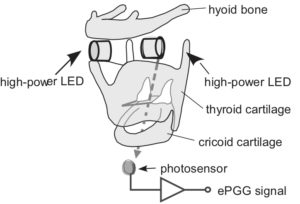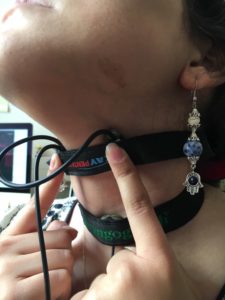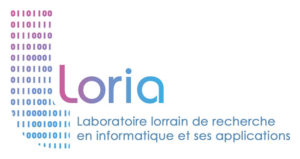The ElectroPhotoGlottoGraphy (ePGG) is a noninvasive system to observe glottal opening and closing
- Based on the photodetection technique:


The two diodes are placed under the top elastic band. The sensor is placed under the bottom elastic band.
Electroglottography [1] is a non-invasive technique which provides a quantitative information about the contact between vocal folds, as well as fundamental frequency as a by-product. The higher the contact between the vocal folds, the stronger the conductance. Conversely, the conductance almost stabilizes at zero as soon as the vocal folds are separated. This means that the temporal evolution of the glottis area is not precisely known as soon as there is no longer contact. This is an important weakness since this area has a direct impact about the airflow in the vocal tract.
All these reasons motivated the development of the ElectroPhotoGlottoGraphy (EPGG) by Honda and Maeda [2], which provides information on the glottis opening area without being invasive. The principle consists in injecting light above the glottis and using a photosensitive sensor placed below the glottis to detect the light flow that depends directly on the surface of the opening. To avoid, or at least limit, the influence of visible light (natural or artificial) Honda and Maeda used infrared light. The system therefore consists of two infrared diodes to emit light above the vocal folds and a photosensitive sensor placed below the glottis. A measuring unit and a microphone complete the device.
https://www.canal-u.tv/video/lpp/short_presentation_of_the_epgg_angelique_amelot_2019.49151
References:
[1] E. Abberton and A. Fourcin, in Instrumental Clinical Phonetics, M. J. Ball and C. Code, Eds. London, Apr. 2008, ch. Electrolaryngography, pp. 119–148, ISBN : 9780470699119. DOI : 10.1002/9780470699119.ch5.
[2] K. Honda and S. Maeda, “Glottal-opening and airflow pattern during production of voiceless fricatives: A new non-invasive instrumentation.”, Journal of the Acoustical Society of America, vol. 123, no. 5, p. 3788, 2008.





